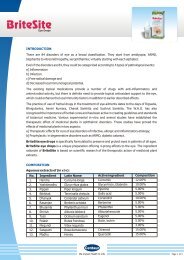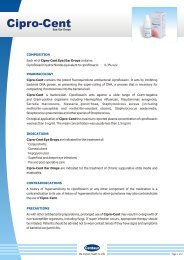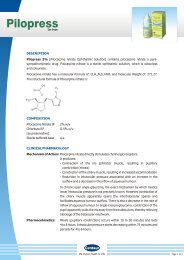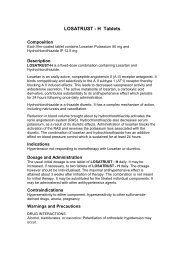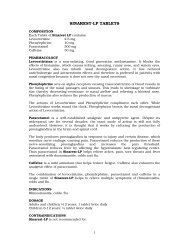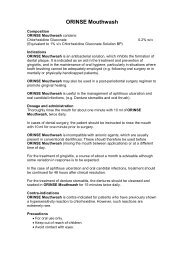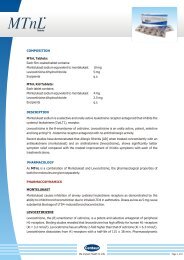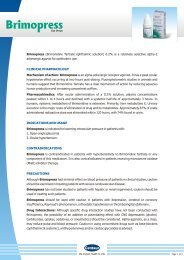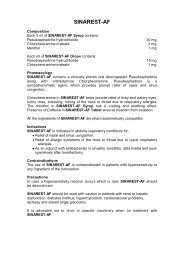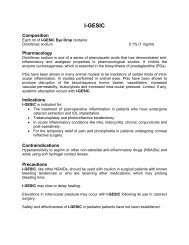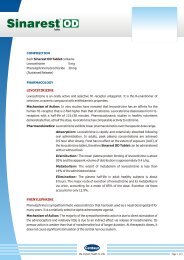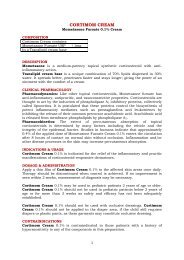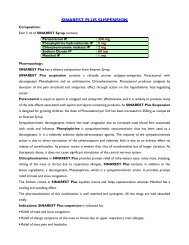Oxop-D Eye Drops
Oxop-D Eye Drops
Oxop-D Eye Drops
You also want an ePaper? Increase the reach of your titles
YUMPU automatically turns print PDFs into web optimized ePapers that Google loves.
DESCRIPTIONOXOP-D <strong>Eye</strong> / Ear <strong>Drops</strong> is a combination of Ofloxacin, a fluoroquinolone antimicrobial anddexamethasone, a potent corticosteroid.COMPOSITIONEach ml of OXOP-D <strong>Eye</strong>/Ear <strong>Drops</strong> contains:Ofloxacin IP0.3% w/vDexamethasone sodium phosphate IPequivalent to Dexamethasone0.1% w/vBenzalkonium Chloride IP0.01% w/vSterile aqueous baseq.s.CLINICAL PHARMACOLOGYOfloxacin has in vitro activity against a broad range of gram-positive and gram-negative aerobicand anaerobic bacteria. It is bactericidal at concentrations equal to or slightly greater thaninhibitory concentrations.Ofloxacin is thought to exert a bactericidal effect on susceptible bacterial cells by inhibiting DNAgyrase, an essential bacterial enzyme that is a critical catalyst in the duplication, transcription, andrepair of bacterial DNA.Ofloxacin has been shown to be active against most strains of the following organisms both in vitroand clinically:Aerobic Gram-Positive:Staphylococcus aureusStaphylococcus epidermidisStreptococcus pneumoniaeAnaerobic Species:Propionibacterium acnesAerobic Gram-Negative:Enterobacter cloacaeHaemophilus influenzaeProteus mirabilisPseudomonas aeruginosaSerratia marcescensMoraxella catarrhalisEscherichia coliCorticosteroids like Dexamethasone suppress the inflammatory response to a variety of agents.Since they may inhibit the body's defense mechanism against infection, a concomitantantimicrobial drug may be necessary when this inhibition is considered to be clinically significant.The combination of Dexamethasone a potent corticosteroid and Ofloxacin a broad spectrumantibacterial in a topical formulation like OXOP-D <strong>Eye</strong>/Ear <strong>Drops</strong> will together effectively resolveinflammation and infection in severe eye conditions.INDICATIONSOXOP-D is indicated for steroid-responsive inflammatory ocular conditions for which acorticosteroid is indicated and where bacterial ocular infection or a risk of infection exists.Page 1 of 3
OXOP-D is indicated in inflammatory conditions of the palpebral and bulbar conjunctiva, corneaand anterior segment of the globe where the inherent risk of steroid use in certain infectiveconjunctivitis is accepted to obtain a diminution in edema and inflammation.OXOP-D is also indicated in chronic anterior uveitis and corneal injury from chemical radiation,thermal burns, or penetration of foreign bodies, where the risk of infection is high or where there isan expectation that potentially dangerous numbers of bacteria will be present in the eye.OXOP-D is also indicated for the treatment of ear infections accompanied by inflammation such asotitis externa, acute and chronic otitis media. OXOP-D may be used postoperatively.DOSAGE & ADMINISTRATIONFor ocular conditions:One or two drops instilled into the conjunctival sac every 4 to 6 hours.During the initial 24 to 48 hours, the dosage may be increased to one to two drops every 2 hours.Frequency should be decreased gradually or warranted by improvement in clinical signs.Care should be taken not to discontinue therapy prematurely.For otic conditions:Instill 2-4 drops 3-4 times daily.CONTRAINDICATIONSThe use of OXOP-D <strong>Eye</strong> / Ear <strong>Drops</strong> is contraindicated in patients with hypersensitivity to anyingredient of the formulation.The use of OXOP-D <strong>Eye</strong> / Ear <strong>Drops</strong> is also contraindicated in epithelial herpes simplex keratitis(dendritic keratitis), vaccinia, varicella, and in other viral diseases of the conjunctiva and cornea,mycobacterial infection of the eye and fungal diseases of ocular structures.WARNINGSOXOP-D <strong>Eye</strong> / Ear <strong>Drops</strong> solution should not be injected subconjunctivally, nor should it beintroduced directly into the anterior chamber of the eye.PRECAUTIONSThe prolonged use of antibiotics may occasionally result in overgrowth of nonsusceptibleorganisms, including fungi. If new infections appear the drug should bediscontinued and appropriate measures instituted. In all serious infections the topical use ofOXOP-D <strong>Eye</strong>/Ear <strong>Drops</strong> should be supplemented by appropriate systemic medication.Prolonged use of OXOP-D <strong>Eye</strong> / Ear <strong>Drops</strong> may result in glaucoma and posterior subcapsularcataract formation. If these products are used for 10 days or longer, intra-ocular pressure should beroutinely monitored even though it may be difficult in children and uncooperative patients.Pregnancy: There are no adequate and well-controlled studies in pregnant women.OXOP-D <strong>Eye</strong>/Ear <strong>Drops</strong> should be used during pregnancy only if the potential benefit justifiesthe potential risk to the fetus.Lactation: It is not known whether topical administration of corticosteroids would result insufficient systemic absorption to produce detectable quantities in human milk. It is also not knownwhether Ofloxacin is excreted in human milk following topical ophthalmic administration. Becausemany drugs are excreted in human milk, caution should be exercised when the combination isadministered to a nursing woman.Page 2 of 3
Moreover, because of the potential of serious adverse reactions from Ofloxacin in nursing infants, adecision should be made whether to discontinue nursing or to discontinue the drug taking intoaccount the importance of the drug to the mother.Pediatric Use: Safety and effectiveness in pediatric patients have not been established.ADVERSE REACTIONSAdverse effects have occurred with steroid/anti-infective combination drugs, which can beattributed to the steroid component, the anti-infective component, or the combination.The most frequently reported drug-related adverse reactions seen with Ofloxacin are: transientocular burning or discomfort. Other reported reactions include stinging, redness, itching,conjunctivitis/keratitis, periocular/facial edema, foreign body sensation, photophobia, blurredvision, tearing, dryness, and eye pain.The reactions due to the steroid component are: elevation of intraocular pressure with possibledevelopment of glaucoma, and infrequent optic nerve damage, posterior subcapsular cataractformation and delayed wound healing.PRESENTATIONOXOP-D <strong>Eye</strong> / Ear <strong>Drops</strong> is available in bottles of 10 ml.Page 3 of 3



